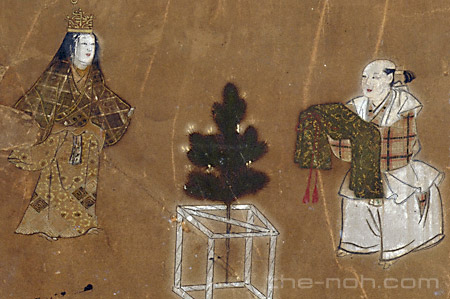
 Hagoromo (Celestial Feather Robe)
Hagoromo (Celestial Feather Robe)

![]()
One spring morning, a fisherman named Hakuryō, sets out to go fishing with his companions and finds a beautiful robe hung on a pine branch at Miho-no-Matsubara.
When he attempts to take it home as a family heirloom, a celestial maiden appears and asks him to return the robe to her. At first, Hakuryō refuses to return it. However, he is moved by the celestial maiden, who laments that she cannot go home to heaven without it. He therefore decides to give her the feather robe in return for seeing her perform a celestial dance.
As the celestial maiden in the feather robe performs the dance, which describes the Palace of the Moon, she praises the beauty of Miho-no-Matsubara in spring. She eventually disappears in the haze, beyond the peak of Mount Fuji.
![]()
This noh drama is based on the well-known legend of the celestial feather robe. In the folk tale, the celestial maiden is compelled to become the wife of the man who hides her feather robe. However, in this noh drama, the generous fisherman, Hakuryō, soon returns the robe to her.
Hakuryō suspects that if he gives the feather robe back to her, she will fly back to the heaven without performing the dance. But the maiden responds that such doubts belongs to the earth but there is no deceit in the celestial world. Honest Hakuryō is impressed by her words and returns the robe to her.
The dance of the celestial maiden is the pillar of this drama and is called Suruga-mai in Azuma-asobi in later years. Zeami's book shows that he considered the dance of the celestial maiden as special. In later generations, the celestial dance is recognized as the archetype of dances; however, the form has been dramatically changed since then.
A calm spring sea, white sand beach, lush green pine trees, exquisite dance of a celestial maiden, and Mount Fuji at the horizon. Both the performers and audience are filled with happiness whether performing or watching this noh drama.
STORY PAPER : Hagoromo (Celestial Feather Robe)
Story Paper presents noh chant stories in modern speech, with story outlines, highlights and more using Adobe PDF format, which can print out and zoom in. Print out the pages and take them with you when you see the actual noh performance.

The copyright of Story Paper is held by the Noh.com. Story Paper is for individual use only. It is prohibited by the copyright law to distribute or publish printed-out Story Paper pages without prior consent. For more information, check the credit and disclaimer pages.



 [Hagoromo (Celestial Feather Robe) : Story Paper PDF : 503KB
[Hagoromo (Celestial Feather Robe) : Story Paper PDF : 503KB